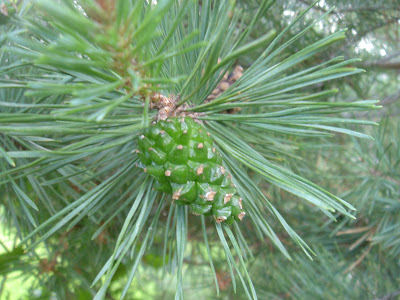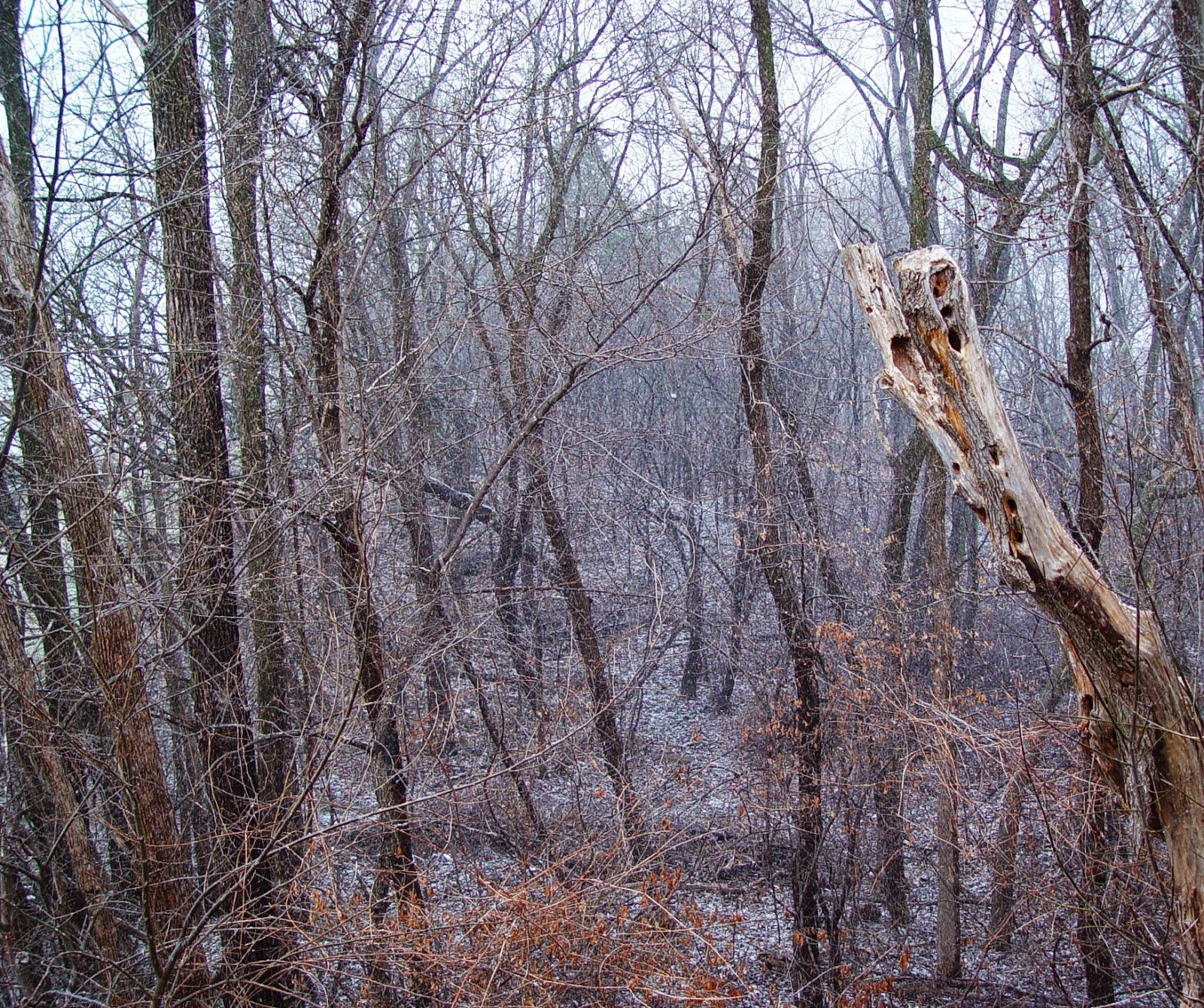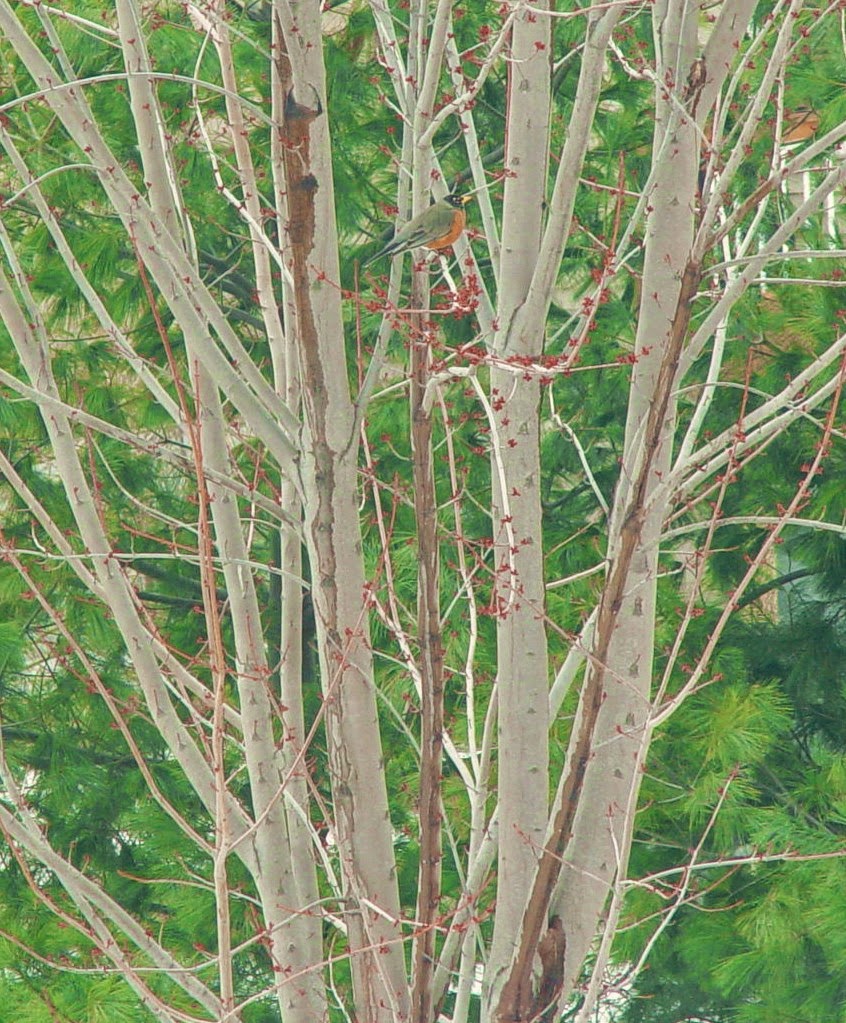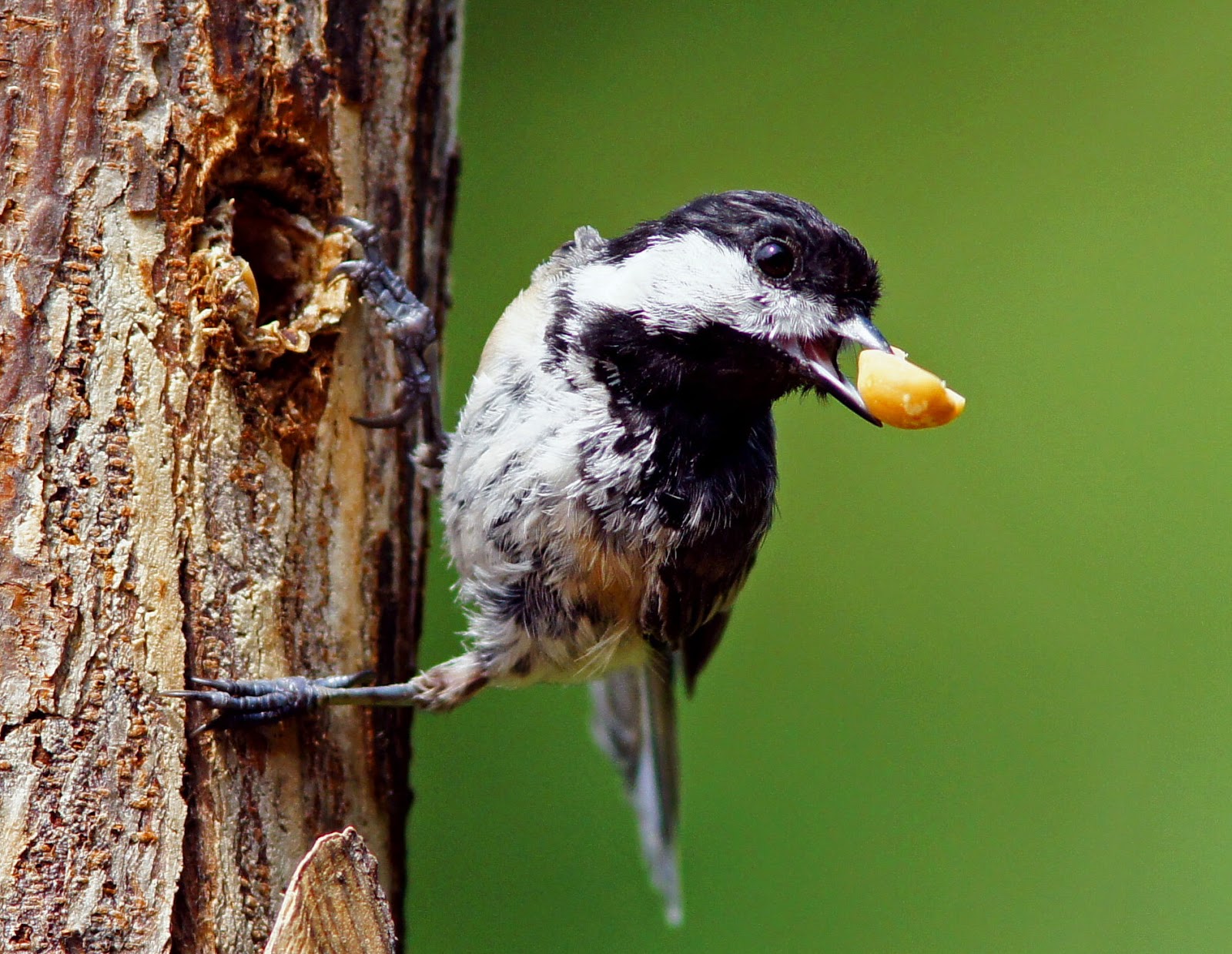6/28/2015
Jack in the Pulpit
The Jack-in-the-Pulpit plants in the wild wild woods have finished flowering. The 1/4" berries cluster and will stay on the stalk until they ripen to red in the autumn. Since there are many young plants around the mature ones, it seems the self-seeding process has been successful in recent years.
a walk in the woods
The warm weather and frequent rains have been good for the green carpet in the woods. Now that green carpet is beginning to bloom. But it requires a close look! These blossoms on Enchanter's Nightshade Circaea lutetiana are just 1/8" to 1/4" across. Each blossom has only 2 petals but often looks like four. The short white hairs will become stiff hooked hairs as the blossom changes to a fruit capsule containing two seeds; the hairs will allow the seeds to cling to anything passing by. Tiny but smart when it comes to species survival.
milkweed and tomatoes
My garden has been invaded by Common Milkweed Asclepias syriaca that used to grow closer to the woods. I usually let some of the stems come up inside the fence; they bloom among the herbs and vegetables so their scent fills the air as I weed and tend the crops. This week, they are beginning to open and release that fragrance! The garden is a delight of tomato vines, greens, beans, peas, squash vines, and scented herbs.
 |
| borage blooming among the tomato vines |
 |
| pollinator on tomato blossom |
6/18/2015
Northern Cardinals
This Spring, the pair of Northern Cardinals claiming the wild wild woods as their nesting territory came often to the tray feeder. The female is a lovely young thing. Her mate sports a strange mix of feathers, not the usual intense red coat of feathers. Maybe he is a very young male who has not grown into his full adult colors. In any case, she felt he was up to the task of helping her raise some offspring.

This week, they are bringing their two youngsters to the seed tray.
6/12/2015
NestWatch: 7 Wren nestlings
One of the nestboxes we watch is used this Spring by House Wrens Troglodytes aedon. Seven eggs hatched on June 8. Today the cam recorded the adults feeding three times within two minutes. The adult Wren is only 4.5 to 5 inches long. She feeds spiders, beetles, caterpillars, earwigs, flies and other insects to her tiny hatchlings. (MP4 video)
In this video, you can see the wriggling legs of the insects she brings in. Wrens keep their nests clean; they wait for the young birds to expel a fecal sac (birdie diaper, poop bag). Until the young birds are 4 or 5 days old, the parents may eat the sacs since the baby's digestive tracts are not very efficient and the sacs may still contain nutrition. Later, they'll carry them away from the box and drop them. This way, the nest lining stays clean and healthy for the crowded clutch of young Wrens.
6/10/2015
6/05/2015
NestWatch: 7 Wren eggs
One of the nestboxes we watch is used this Spring by House Wrens Troglodytes aedon. She has been incubating these seven eggs for nearly two weeks. The male sits in the tree nearby to guard the nest.
6/02/2015
caterpillar
My knowledge of garden pests seems to have evaporated over winter . . .
This 2-inch-long small green worm with a silvery stripe would usually be difficult to detect on green plants, but this one was on a native Penstemon plant with rich maroon stems and leaves.
Since there is so much concern about loss of butterflies and bees, I want to encourage any that I can.
To my chagrin, I realized it is a cabbage looper!
This caterpillar is the larval form of the white cabbage moth, Trichoplusia ni. They love plants in the veggie garden -- broccoli, cauliflower, kohlrabi, cabbage, collard greens, potato, tomato, spinach, and cucumbers. They typically eat holes in the leaves and hide out on the bottom side of the foliage.
5/31/2015
new growth among the evergreens
5/27/2015
5/10/2015
4/10/2015
April - more signs of Spring . . .
3/26/2015
March - signs of Spring in Minnesota
The maple trees are seeping sap and bursting buds. The Robins are back for the nesting season. I'm sure I've heard the sound of warblers singing . . . .
3/23/2015
Southwest USA study trip III
While studying wildflowers among cactus in the Southwest, I spotted birds we probably won't see around here . . . .
Gambel's Quail (nests on the ground, eats grasses and cactus fruits)
Cactus Wren (nests in woodpecker holes, loud and boisterous)
Gila Woodpecker (makes nest holes in palms and saguaros)
Greater Roadrunner (hides nest in center of cactus thorns, here taking a lizard to the nest)



3/22/2015
Southwest USA study trip II
Also spotted at the wetlands preserve, these birds that winter in the south and migrate north in the western USA for nesting season.
top: Cinnamon Teal Anas cyanoptera
middle: American Widgeon Anas americanus
bottom: Lesser Goldfinch Spinus psaltria
3/20/2015
Southwest USA study trip
Just returned from studying wildflowers in the Southwest USA.
At a wetland preserve area, we saw some of the birds that are wintering there but will return to Minnesota for nesting season.
top: Northern Shoveler male Anas clypeata
middle: Common Moorhen Gallinula galeata
 bottom: Mallard female Anas platyrhynchos
bottom: Mallard female Anas platyrhynchos1/03/2015
January - winter buds
 |
| Bayberry Myrica pensylvanica |
On winter days like these . . .
cold and windy . . .
it may look like the trees in the
wild wild woods are bare,
but when I take a closer look . . .
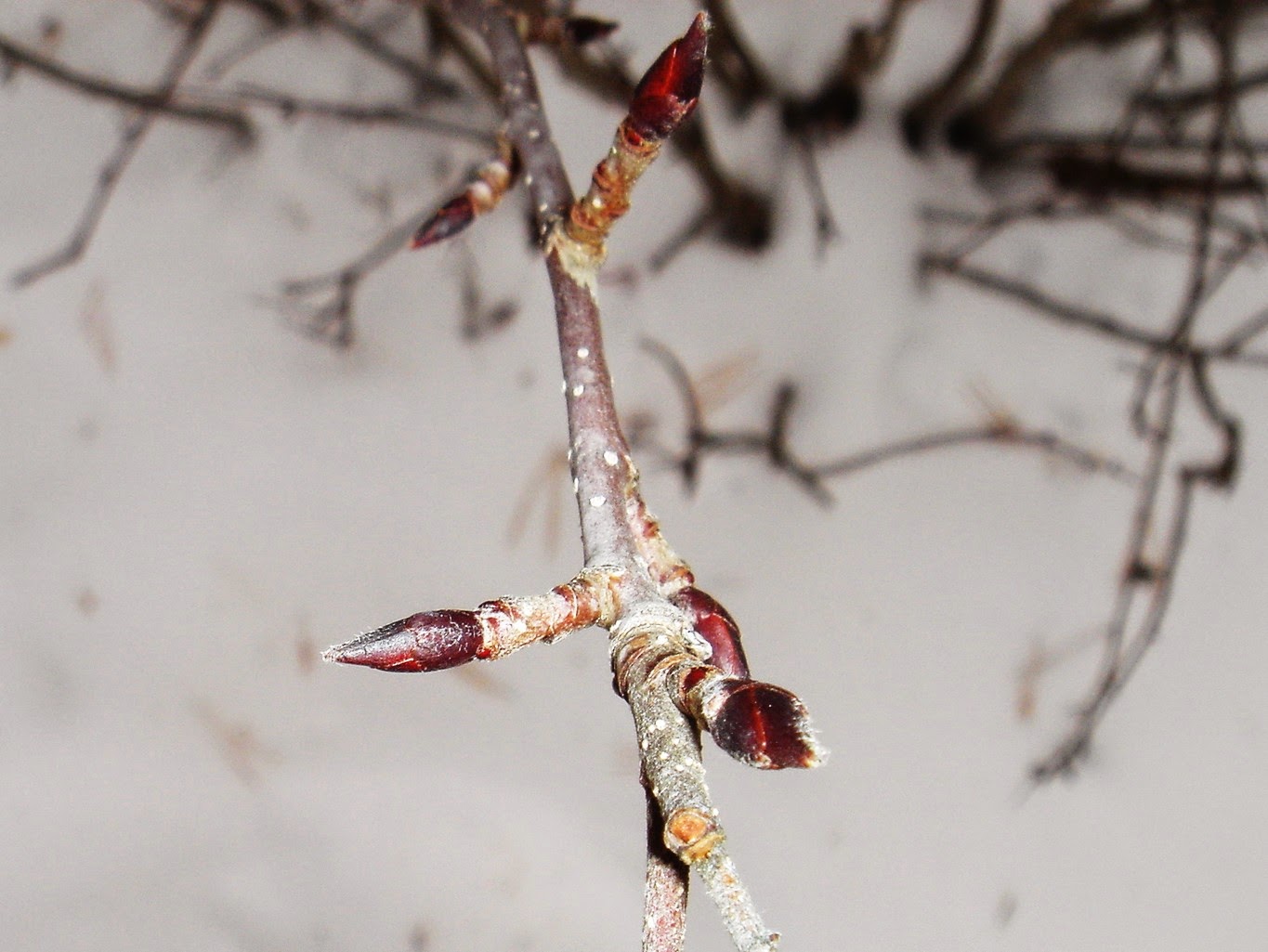 |
| Black Chokeberry Aronia melanocarpa |
 |
| Viburnum (left), Forsythia (above), Lilac (below) |

These deciduous trees and shrubs actually formed buds last summer during their active growing season. To survive the cold of winter they have gone dormant.
But next spring's burgeoning leaves and flowers are already in place, so the trees won't need to use energy now to grow those complex leaf and flower structures.
12/29/2014
hawk watch
The Cooper's Hawk we often see in the wild wild woods was back again today. First, we saw it sitting for several minutes in the sun on a branch of the maple tree. With yellow feet tucked under feathers, it tried to fluff the down underlayer and stay warm on this 10F cold day. After a failed attempt to catch a Junco in the understory, the hawk sat for a minute in the willow tree, then wandered off to another location.
12/01/2014
11/14/2014
tree harvest
Birds survive winter on available seeds wherever they can find a harvest. Birch trees offer seeds hanging in clusters for American Goldfinches and Dark-eyed Juncos.
The seed pods on Boxelder trees are savored by Grey Squirrels too.
winter water
At the edge of the wild wild woods, I keep a bowl with open water for the birds. Many species use it to drink and to preen their feathers even in cold weather. Feathers do their job of insulating for warmth better when they are clean. The Northern Flicker Colaptes auratus often drums on the ground to find ant larvae to eat. That may make him thirsty. The Blue Jay Cyanocitta cristata occasionally dives in for a full bath.


10/02/2014
windblown
Bluejays love peanuts! This bird was trying hard to get one even though the wind almost flipped him head over tail.
9/01/2014
young birds
Several bird species were successful at hatching and fledging babies this summer in the wild wild woods.
This young Black-capped Chickadee found a peanut too big for him, but he can peck at it to manage a treat.
This Downy Woodpecker male (with the red cap) is feeding a young at the suet block, hoping he will learn to help himself before winter sets in.
The two big guys below may look like a battling pair. The brown one is a juvenile Common Grackle begging from his parent at the seed tray. This is how young birds learn to fend for themselves.
Subscribe to:
Comments (Atom)








